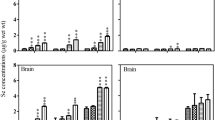Abstract
The transfer of Se (Na2SeO4) was followed through a laboratory food chain (wateralgae-rotifer-larval fish) and its effect on larval fathead minnows (Pimephales promelas). Selenium transfer between algae (Chlorella pyrenoidosa) and rotifers (Brachionus calyciflorus) was a function of time and food availability. Selenium concentrations in the rotifers ranged from 46 to 91Μg Se · g−1 dry weight after 5 hr of feeding. Selenium concentrations (±SD) in larval fish reached 61.1±1.1 Μg Se · g−1 dry weight for 9 day-old larvae and 51.7+1.6 Μg Se · g−1 for 17 day-old larvae after 7 and 9 days of feeding with Se-contaminated rotifers, respectively. Final dry weights of larvae fed Se-contaminated rotifers were significantly lower than those of controls, although acute toxicity (mortality) was not demonstrated. The biological halflife of food-derived Se in the larvae was 28 days.
Similar content being viewed by others
References
Andren AW, Klein DH (1975) Selenium in coal-fired steam plant emissions. Environ Sci Techno1 9:856–858
Bennett WN (1984) Examination of selenium kinetics and transfer within a defined aquatic food chain. MS Thesis. Dept of Zoology, University of Wisconsin-Milwaukee, 61p
Benoit DA, Puglis FA, Olson DL (1982) A fathead minnowPimephales promelas early life stage toxicity test method evaluation and exposure to four organic chemicals. Environ Pollut (Series A) 28:189–197
Bertine KK, Goldberg ED (1971) Fossil fuel combustion and the major sedimentary cycle. Science 173:233–235
Bertram PE, Brooks AS (1986) Kinetics of accumulation of selenium from food and water by fathead minnows. Water Res (in press)
Boraas ME (1983) Population dynamics of food-limited rotifers in two-stage chemostat culture. Limnol Oceanogr 28:546–563
Bottino NR, Banks CH, Irgolic KJ, Micks P, Wheeler AE, Zingaro RA (1984) Selenium containing amino acids and proteins in marine algae. Phytochem 23:2445–2452
Boyden CR (1974) Trace element content and body size in molluscs. Nature 251:311–314
Boyum KW (1984) The toxic effect of selenium on the zooplankton,Daphnia magna andDaphnia pulicaria, in water and the food source (Chlamydomonas reinhardtii). PhD Thesis. Dept of Zoology, University of Wisconsin-Milwaukee. 126 pp
Cardwell RD, Foreman DG, Payne TR, Wilber DJ (1976) Acute toxicity of selenium dioxide to freshwater fishes. Arch Environ Contam Toxicol 4:129–144
Cutter GA (1982) Selenium in reducing waters. Science 217:829–831
Demayo A, Taylor MC, Reeder SW (1979) Guidelines for surface water quality. Vol. 1. Inorganic chemical substances. Selenium. Inland Waters Directorate. Water Quality Branch, Ottawa, Canada
Fowler SW, Benayoun G (1976) Influence of environmental factors on selenium flux in two marine invertebrates. Mar Biol 37:59–67
Gissel-Nielsen M, Gissel-Nielsen G (1978) Sensitivity of trout to chronic and acute exposure to selenium. Agric Environ 4:85–91
Gutenmann WH, Bache CA, Youngs WD, Lisk DJ (1976) Selenium in fly ash. Science 191:966–967
Halter MT, Adams WS, Johnson HE (1980) Selenium toxicity toDaphnia magna, Hyallela azteca and fathead minnow in hard water. Bull Environ Contam Toxicol 24:102–107
Hilton JW, Hodson PV, Slinger SJ (1980) The requirement and toxicity of selenium in rainbow trout (Salmo gairdneri). J Nutr 110:2527–2535
— (1982) Absorption, distribution, half-life and possible routes of elimination of dietary selenium in juvenile rainbow trout (Salmo gairdneri). Comp Biochem Physiol 71C:49–56
Hodson PV, Spry DJ, Blunt BR (1980) Effects on rainbow trout (Salmo gairdneri) of a chronic exposure to waterborne selenium. Can J Fish Aquat Sci 37:233–240
Hutner SH, Provosli L, Schatz A, Haskins C (1950) Some approaches to the study of the route of metals in the metabolism of microorganisms. Proc Am Phil Soc 94:152–170
Kleinow KM, Brooks AS (1986) Selenium compounds in the fathead minnow (Pimephales promelas)-I. Uptake, distribution, and elimination of orally administered selenate, selenite and 1-selenomethionine. Comp Biochem Physiol 83C:61–69
National Research Council, Committee on Medica1 and Biological Effects of Environmental Pollutants (1976) Selenium. National Academy of Sciences, Washington, DC
Niimi AJ, LaHam QN (1976) Relative toxicity of organic and inorganic selenium compounds to newly hatched zebrafish (Brachydanio rerio). Can J Zool 54:501–509
Rotruck JT, Pope AL, Ganther HE, Swanson AB, Hafeman DG, Hoekstra WG (1973) Selenium: Biochemical role as a component of glutathione perioxidase. Science 179:588–590
Sandholm M, Oksanen HE, Pesonen L (1973) Uptake of selenium by aquatic organisms. Limnol Oceanogr 18:496–499
Shrift A (1954) Sulfur-selenium antagonism. I. Antimetabolism action of selenate on the growth ofChlorella vulgaris. Am J Bot 41:223–230
Sokal RR, Rohlf FJ (1981) Biometry, 2nd ed. WH Freeman, San Francisco, CA
Starkweather PL, Gilbert JJ (1977) Radiotracer determination of feeding inBrachionus calyciflorus: The importance of gut passage times. Arch Hydrobiol Beih Ergebn Limnol 8:261–263
Turner MA, Swick AL (1983) The English-Wabigoon River system: IV. Interaction between mercury and selenium accumulated from waterborne and dietary sources by northern pike (Esox lucius). Can J Fish Aquat Sci 40:2241–2250
Underwood EJ (1971) Selenium. In: Trace Elements in Human and Animal Nutrition, 3rd ed. Academic Press, New York
Wrench JJ (1978) Selenium metabolism in the marine pytoplanktersTetraselmis tetrathele andDunaliella minuta. Mar Biol 49:231–236
Author information
Authors and Affiliations
Additional information
Based on a thesis by William N. Bennett submitted in partial fulfillment for the degree of Master of Science in Zoology at the University of Wisconsin-Milwaukee.
Rights and permissions
About this article
Cite this article
Bennett, W.N., Brooks, A.S. & Boraas, M.E. Selenium uptake and transfer in an aquatic food chain and its effects on fathead minnow larvae. Arch. Environ. Contam. Toxicol. 15, 513–517 (1986). https://doi.org/10.1007/BF01056563
Received:
Revised:
Issue Date:
DOI: https://doi.org/10.1007/BF01056563




